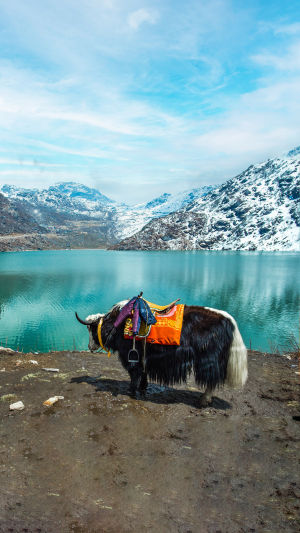Dear Lykkers! Tsomgo Lake, also known as Tsongmo or Changu Lake, is a stunning glacial lake nestled in the mountains of East Sikkim, India.
This pristine lake, perched at an altitude of 3,753 meters (12,313 feet), is renowned for its crystal-clear waters, alpine beauty, and cultural significance. Surrounded by rugged mountains and a tranquil landscape, Tsomgo is an unmissable destination for anyone visiting Sikkim.
<h3>How to Get There</h3>
<b>By Air:</b> The nearest airport is Pakyong Airport (31 km from Gangtok), but most travelers use Bagdogra Airport (124 km), with frequent flights to major Indian cities.
<b>By Road:</b> Tsomgo Lake is 38 km from Gangtok, the capital of Sikkim. Shared jeeps, taxis, and private cars are available from Gangtok, making for a scenic, hour-long drive to the lake.
<b>Permit Requirement:</b> As Tsomgo Lake lies near the Indo-China border, a special permit is required for entry. Indian nationals can obtain the permit easily through travel agents or hotels in Gangtok. Foreign nationals need additional clearances, and certain restrictions apply.
TSOMGO (CHANGU) LAKE | Sikkim | Changu Lake in January 2020 | Tsomgo Lake (Gangtok)
Video by Travels to Earth
<h3>Natural Beauty and Changing Seasons</h3>
Tsomgo Lake's appearance changes with the seasons, offering unique experiences year-round:
<b>Winter Wonderland:</b> From November to March, the lake often freezes, transforming into a white wonderland. Snow blankets the surrounding mountains, creating a serene, icy landscape perfect for photography.
<b>Spring Bloom:</b> During spring and early summer, the area around Tsomgo blooms with vibrant wildflowers, including the rare rhododendrons, and primulas which add color to the lake's surroundings.
<b>Summer Splendor:</b> In summer, the lake's waters thaw, creating a breathtaking mirror-like surface that reflects the majestic peaks around it, with a peaceful atmosphere that draws visitors to its shores.
<h3>Spiritual and Cultural Significance</h3>
Tsomgo Lake holds deep spiritual value for the local Sikkimese people. The lake is believed to be sacred, and it is a site for several spiritual rituals. During some auspicious festivals, locals come to the lake to offer prayers. The lake's waters are also said to possess healing powers, drawing spiritual seekers and curious travelers alike.
<h3>Activities at Tsomgo Lake</h3>
<b>Yak Rides:</b> One of the most popular experiences at Tsomgo Lake is a traditional yak ride. Yaks, adorned with colorful decorations, allow visitors to enjoy the lake from a unique perspective as they ride along the shore.
<b>Photography:</b> The lake's picturesque setting, especially when covered in snow or surrounded by flowers, makes it a paradise for photographers. The reflection of the mountains on the lake's surface creates stunning photographic opportunities.
<b>Visit Baba Mandir:</b> Just a short drive from Tsomgo Lake, the Baba Harbhajan Singh Memorial Temple is another significant site, honoring a soldier of the Indian army who is venerated by locals and soldiers alike.
<h3>Accommodation</h3>
Accommodation options near Tsomgo Lake are limited, but travelers often stay in Gangtok, which offers a range of hotels, from budget stays to luxury resorts.
<h3>Dining</h3>
At the lake, small stalls serve warm beverages like tea and coffee, as well as snacks such as momos, noodles, and Maggi. These simple treats are perfect to enjoy in the chilly mountain air.
<h3>Best Time to Visit</h3>
The best time to visit Tsomgo Lake is from April to June when the lake is accessible and the flowers are in bloom, or from October to December for those seeking a winter wonderland. However, the road to Tsomgo may be blocked by snow in January and February, so plan accordingly.
Tsomgo Lake is a magical destination that captivates with its scenic beauty, cultural significance, and unique alpine charm. Whether you're looking to explore spiritual sites, enjoy adventurous rides, or simply take in the beauty of the Himalayan landscape, a visit to Tsomgo Lake promises an unforgettable experience in the heart of Sikkim's natural beauty.





